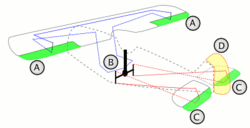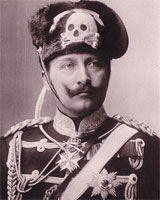INCREDIBLY ADVANCED AIRCRAFT TECHNOLOGY EXISTED BEFORE THE GREAT FLOOD, AND ANCIENT INDIA HAD REMNANTS OF THAT ADVANCED TECHOLOLGY!! |
When Alexander the Great tried to conquer India, his soliders were confronted by advanced flying machines called VIMANAS, which terrified his soldiers, and he had to abandon his dream of world conquest:
That some lingering Vimanas were still around several thousand years after the destruction of Rama and Atlantis is evidenced by certain "UFO" accounts in ancient history. According to several researches such as Frank Edwards, when Alexander the Great invaded India in 326 B.C., two shining silvery shields spitting fire around the rims dived repeatedly on the Greek columns descending the mountain passes into the Punjab, stampeding the horses and elephants. The shields then returned to the skies and vanished. Alexander's men refused to go further than the river they had been attempting to cross, and Alexander's conquest of India was abandoned (Childress, Vimana: Aircraft of Ancient India and Atlantis, p. 298).
Evilutionists deny that incredibly advanced engineering technology existed in the ancient world. It is just part of their wicked agenda to deny the reality of the Great Flood . . . and the Second Coming of Christ.
Octave Chanute was the son of Joseph Chanute, professor at the Collège de France, and emigrated with his father to the United States of America in 1838, when the former was named Vice-President at Jefferson College in Louisiana. Octave attended private schools in New York.
Samuel Pierpont Langley was an American astronomer, physicist, inventor of the bolometer and pioneer of aviation.
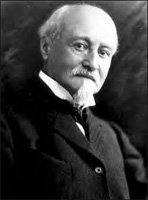 Octave Chanute (1832–1910). |
|
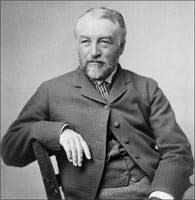 Samuel Langley (1834–1906). |
Octave Chanute was widely considered brilliant and innovative in the engineering profession. During his career he designed and constructed the United States' two biggest stock yards, Chicago Stock Yards (1865) and Kansas City Stockyards (1871). He designed and built the Hannibal Bridge which was the first bridge to cross the Missouri River in Kansas City, Missouri, in 1869 and established Kansas City as the dominant city in the region. He designed many other bridges during his railroad career, including the Illinois River rail bridge at Peoria, Illinois, the Genesee River Gorge rail bridge near Portageville, New York (now in Letchworth State Park), the bridge across the Missouri River at Sibley, Missouri, across the Mississippi River at Fort Madison, Iowa, and the Kinzua Bridge in Pennsylvania.
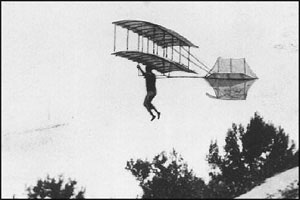 Chanute and his 1896 biplane hang glider, a trailblazing design plagiarized by the Wright brothers. |
|
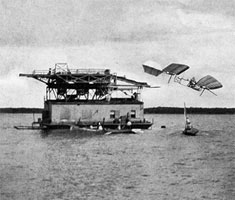 Langley's aerodrome was a viable flying machine by Oct, 1903. |
The airplane was perfectly capable of manned flight but the catapult system was sabotaged. It crashed moments after takeoff but the pilot survived. The British owned Washington Post and the New York Times ridiculed him mercilessly and called him a "birdbrain."
A Congressman named Robinson said "that the only thing he ever made fly was government money." The abuse heaped on his head by the press and members of Congress was enough to make him give up his attempts at manned flight. The professor had a timely demise just 7 years later. Subsequent trials showed that the aerodrome was quite capable of manned flight.
The 2 British Secret Service agents turned aeronautical engineers!!
The Wright Brothers were 2 "bicycle shop mechanics" turned aeronautical engineers. They are credited with inventing and building the world's first successful airplane and making the first controlled, powered and sustained heavier-than-air human flight. The brothers were called the "Bishop's Boys" because their father was a "Bishop" in the Church of the United Brethren in Christ. He never read the verse in Genesis that says that "spies are despicable" (Genesis 42:31).
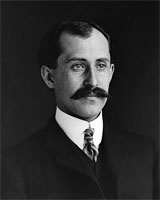 Orville Wright (1871–1948). |
|
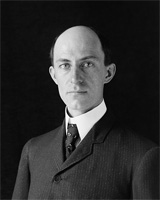 Wilbur Wright (1867–1912). |
The Wright brothers reported to 2 men in London: Baden Fletcher Smyth Baden-Powell and Patrick Young Alexander. Baden-Baden Powell was "Mr. British Empire" personified and he was the brother of the Boer War Colonel Robert Baden-Powel–founder of the Boy Scouts Movement. He was extremely interested in developing the airplane as an instrument of war for expanding the British Empire.
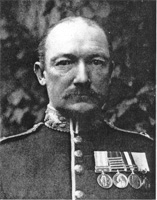 Baden-Baden Powell (1860–1937). |
|
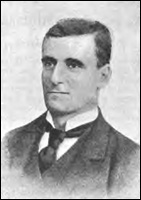 Patrick Alexander (1867–1943). |
Here is an excerpt from an address given by Major Baden-Baden Powell to the British Aeronautical Society on December 4, 1902:
In his address Major Baden-Powell, speaking as a professional soldier, also offered the company his opinion of what the future might hold when a "practical flying machine" was developed at last. He said: "One can scarcely imagine any invention which could have a greater effect on the conduct of warfare ..."
In the audience on that December evening was a curious and remarkable man. His name was Patrick Y. Alexander, a prominent member of the Aeronautical Society of Great Britain. Patrick Alexander made it his business to investigate personally the latest developments in aeronautics wherever they took place, in any part of the world.
He was so interested by what Major Baden-Powell said about the Wright brothers that he left London, almost upon the instant, and travelled to Dayton, Ohio, in order to interview Wilbur and Orville Wright about their experiments. Such was Alexander's ardour and keenness in the matter that he actually called upon the Wrights in their home in Dayton during a family holiday on Christmas Eve, 1902, only three weeks and one day after Baden-Powell had spoken of their latest achievements in his Presidential Address to the Aeronautical Society in London.
As a result of this singular initiative Alexander was now able to tell his friends in the British Army what the Wright brothers had actually accomplished, and what they planned for the future. (Golin, No Longer An Island, pp. 26-27).
Patrick Alexander was the Samuel Insull of the U.S. aviation industry.
In December 1903, the Wright brothers brought their disassembled "airplane" and a catapult from their bicycle shop in Dayton, Ohio, to Kitty Hawk in North Carolina.
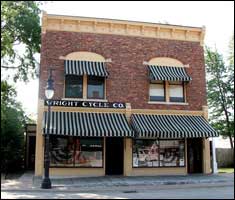 Wright brothers bicycle shop in Dayton, Ohio. |
|
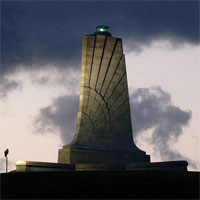 Wright brothers Monument, Kitty Hawk, North Carolina. |
Before setting out, the brothers consulted the U.S. Weather Bureau about the area's steady winds and they found out that it was the perfect location for gliding....They also valued the privacy provided by the location, which in the early twentieth century was remote from major population centers.
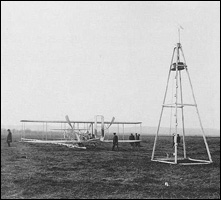 The Wright brothers cumbersome launching derrick. |
|
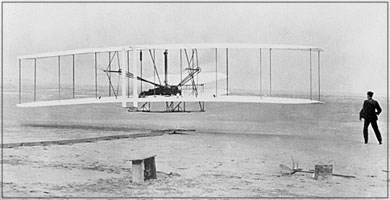 Iconic photo of the Wright brothers "flight" lacks the catapult that launched the glider. |
No newspaper reporters were present for an independent verification of that epochal event. It never occurred to the 2 bicycle shop mechanics to put WHEELS on their aircraft in order for it to take off as a powered flyer . . . and not as a glider.
In 1904, the brothers hired a patent lawyer named Harry A. Toulmin and asked him to file a patent covering every aspect of manned flight . . . except wheels. All they had to show the lawyer was the phony photograph from Kitty Hawk.
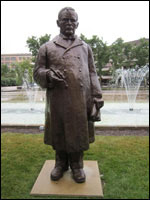 Harry A. Toulmin (1858–1942) statue in Springfield, Ohio. |
|
Toulmin's patent covered almost every aspect of manned flight . . . except wheels. |
Toulmin also filed the Wright brothers patent in England, France, Germany, Austria, Italy, Russia, and Belgium:
The application Harry Toulmin filed with the United States Patent Office in March 1904 would set the course of American aviation for the next thirteen years. Rather than simply specify the elements of Wilbur's wing-warping system as a mechanical construction, Toulmin expanded the notion of wing warping to cover any system where the angle of any device at the wing tips varied the "lateral margins" in opposite directions from the angle of wings at the centers. Thus Toulmin altered the patent from seeking exclusivity for a device to seeking exclusivity for an idea, the principle of lateral control itself. If such a patent was granted and ratified by the courts, it would apply to configurations that the Wrights themselves had not employed or even conceived of and so virtually no aircraft could subsequently be flown without licensing by Orville and Wilbur, precisely the breath they were seeking. (Goldstone, Birdmen: The Wright Brothers, Glenn Curtis, and the Battle to Control the Spies, pp. 86-87).
The stage was set for a monumental international legal battle that would delay aviation development in the United States . . . and France.
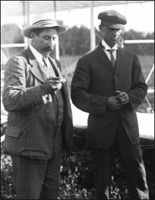 Hart O. Berg (left), the Wrights' European business agent, and Wilbur at the flying field near Le Mans. |
|
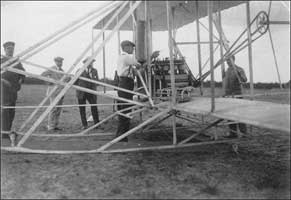 Orville preparing his wheelless plane for takeoff at LeMans, France. |
Most of the time the Wright brothers spent in France was negotiating to have their "airplane" purchased by the French government. 2 men helped them accomplish that: Henri Deutsch de la Meurthe and French Minister of War, Marie Georges Picquart.
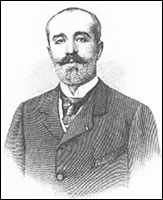 Henri Deutsch de la Meurthe (1846–1919). |
|
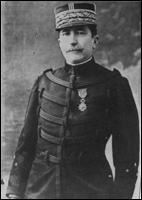 Marie Georges Picquart (1854–1914). |
The U.S. military was also interested in the Wright brothers plane so a fearless army lieutenant decided to join Orville for a flight.
 Thomas Selfridge (1882–1908). |
|
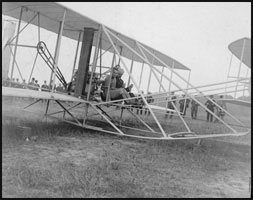 Orville Wright and Thomas Selfridge preparing for takeoff. |
Unfortunately, lieutenant Selfridge was killed in the accident but Orville survived suffering only a few broken bones.
The Aerial Experiment Association made the first public flight in 1908
The Aerial Experiment Association (AEA), was a Canadian-American pioneering research group, founded by Alexander Graham Bell at Beinn Bhreagh, Nova Scotia, to build flying machines.
2 of its most prominent members were Glenn Curtiss and Casey Baldwin.
Glenn Curtiss lived in the town of Hammondsport, New York. He began his career as a bicycle racer and builder before moving on to motorcycles. As early as 1904, he began to manufacture engines for airships.
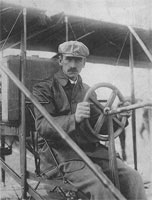 Glenn Curtiss (1878–1930). |
|
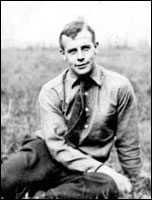 Casey Baldwin (1882–1948). |
Glenn wasn't obsessed with secretly like the "Bishop's Boys." He even offered his more powerful engine to the brothers, but was refused. He didn't go running off to the patent office either to create a monopoly and get rich.
As a member of the Aerial Experiment Association (AEA), Glenn worked with inventors like Alexander Graham Bell, Octave Chanute, and Casey Baldwin.
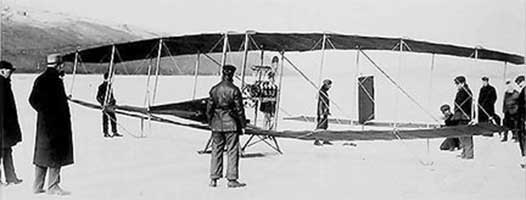 The White Wing, piloted by Casey Baldwin, and taking off on sled runners, made the first public flight on March 12, 1908. |
|
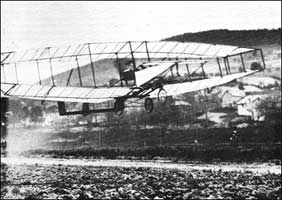 The Red Wing, piloted by Casey Baldwin, was the first U.S. plane with wheels. |
The White Wing, piloted by Casey Baldwin, made the first public flight on March 12, 1908. The Red Wing was the first plane to have a wheeled undercarriage and it was first flown by Casey on May 18, 1908.
The Aerial Experiment Association was dissolved in 1909, and Glenn Curtiss formed a company with another man named Augustus Herring. The new company was called the Herring-Curtiss Company.
The Wright brothers tried to ground the Herring-Curtiss Company!!
On January 10, 1910, corrupt federal judge John Hazel issued an injunction forbidding the Herring-Curtiss Company from manufacturing, selling, or flying for profit. John Hazel is best known as the judge who swore in Confederate Teddy Roosevelt as President.
The judge based his injunction on the Wright brothers broad patent that was issued in 1906, without the brothers having to demonstrate that their "airplane" could fly.
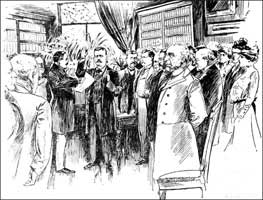 Judge Hazel swore in Confederate Teddy Roosevelt as President. |
|
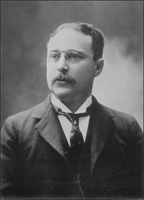 Judge John R. Hazel (1860–1951). |
Hazel was hell-bent on grounding every airplane in the world . . . except those manufactured by the Wright brothers:
On January 3, 1910, one week before the air meet was to begin, federal district court judge John R. Hazel granted the Wright Company's request for an injunction enjoining the Herring-Curtiss corporation and Glenn Curtiss and Augustus Herring personally from manufacturing, selling, or flying airplanes for profit. Hazel, with no training in aerodynamics, nonetheless went into great detail in an opinion that accepted every assertion of the Wrights and none of Curtiss and concluded that it was "not improbable they may succeed at final hearing, and therefore a preliminary injunction be granted." Harry Toulmin wrote to Wilbur and Orville, "You have much to be thankful for ... his opinion follows our brief in reasoning and conclusions; much of it adopts our language." Although the writ was aimed only at one competitor, as the Wright Company had announced that every airplane currently in use infringed on their patent, similar orders were soon to follow. (Goldstone, Birdmen: The Wright Brothers, Glenn Curtis, and the Battle to Control the Spies, p. 181).
It just so happened that the great French nation was also in the forefront of aviation technology development so that injunction was also meant to ground their aerospace industry.
By 1910, France desperately needed a bomber to reach Berlin!!
By 1910, the French Republic was threatened with invasion by "Kaiser Bill"–the grandson of Queen Victoria. What the French needed was a few bombers to reach Berlin and threaten the Kaiser with retaliation. The Wright brothers patent suit delayed the development of the aerospace industry until after the war started in 1914.
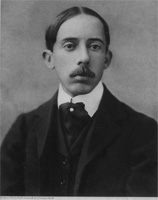 Alberto Santos-Dumont (1873–1932). |
|
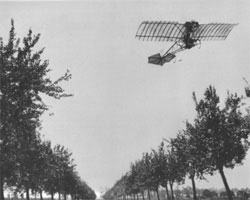 Alberto Santos-Dumont flying the Demoiselle over Paris. |
Louis Blériot was another brilliant French aviation pioneer with so many firsts in his repertoire.
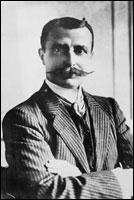 Louis Blériot (1872–1936). |
|
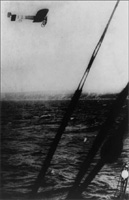 Louis Blériot approaching the White Cliffs of Dover; July 25, 1908. |
Incredibly, the Wrights' patent was also enforced in France:
The preliminary injunctions issued by Judges Hazel and Hand gave the Wright brothers an effective monopoly in the flying-machine business in America for the first six months of 1910. Even when the restraints were removed in June of that year, the Wright patent suits continued to threaten American pilots and aircraft builders. Having forced the Herring-Curtiss Company out of business and placed Glenn Curtiss and other competing aviators in legal jeopardy, the Wrights, through their foreign licensees, launched a direct attack on their European competitors.
Late in 1910, the Compagnie Générale de Navigation Aérienne brought suit against six rival aircraft manufacturers (Blériot, Farman, Esnault-Pelterie, Clément-Bayard, Antoinette, and Santos-Dumont) for infringement on the Wrights' French patents. The case was tried before the Third Civil Tribunal, composed of three judges and a substitute, a state's attorney boasting special technical qualifications. (Crouch, The Bishop's Boys: A Life of Wilbur and Orville Wright, pp. 415-416).
At the very time that the French Republic was facing her greatest peril, aviation development was stalled in the French courts.
|
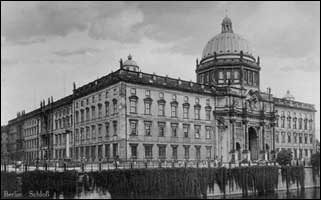 "Kaiser Bill's" palace in Berlin. |
According to experts on the pioneer days of aviation, the Wright brothers' lawsuits in the United States and France delayed the development of aviation by at least 5 years in the crucial years before World War I. It was only the defeat of the British-Prussian axis that allowed the aviation industry to soar once more in France and the United States.
Vital Links
References
Childress, David Hatcher Vimana: Aircraft of Ancient India and Atlantis. Adventures Unlimited Press, Kempton, Illinois, 1991.
Crouch, Tom. The Bishop's Boys: A Life of Wilbur and Orville Wright. W.W. Norton & Company, New York, 1989.
Crouch, Tom. A Dream of Wings: Americans and the Airplane 1875–1905. W.W. Norton & Company, New York, 1981.
Goldstone, Lawrence. Birdmen: The Wright Brothers, Glenn Curtiss, and the Battle to Control the Skies. Ballantine Books, New York, 2014.
Golllin, Alfred. An Island No Longer: Britain and the Wright Brothers 1902–1909. Stanford University Press, Stanford, CA., 1984.
Harwood, Craig S. Quest for Flight: John J. Montgomery and the Dawn of Aviation in the West. University of Oklahoma Press, OK, 2012.
Hoffman, Paul. Wings of Madness: Alberto Santos-Dumont and the Invention of Flight. Theia, New York, 2003.
Penrose, Harald. British Aviation: The Pioneer Years 1903–1914. Putnam, London, 1967.
Roseberry, C.R. Glenn Curtiss: Pioneer of Flight. Syracuse University Press, Syracuse, New York, 1972.
Copyright © 2015 by Patrick Scrivener
